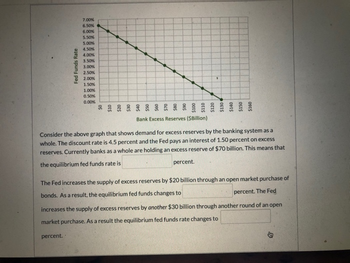
Transcribed Image Text:Fed Funds Rate
7.00%
6.50%
6.00%
5.50%
5.00%
4.50%
4.00%
3.50%
3.00%
2.50%
2.00%
1.50%
1.00%
0.50%
0.00%
$130
$140
$150
$160
Bank Excess Reserves ($Billion)
banking
system as a
Consider the above graph that shows demand for excess reserves by the
whole. The discount rate is 4.5 percent and the Fed pays an interest of 1.50 percent on excess
reserves. Currently banks as a whole are holding an excess reserve of $70 billion. This means that
the equilibrium fed funds rate is
percent.
percent..
The Fed increases the supply of excess reserves by $20 billion through an open market purchase of
bonds. As a result, the equilibrium fed funds changes to
percent. The Fed
increases the supply of excess reserves by another $30 billion through another round of an open
market purchase. As a result the equilibrium fed funds rate changes to
7.00%
6.50%
6.00%
5.50%
5.00%
4.50%
4.00%
3.50%
3.00%
2.50%
2.00%
1.50%
1.00%
0.50%
0.00%
$130
$140
$150
$160
Bank Excess Reserves ($Billion)
banking
system as a
Consider the above graph that shows demand for excess reserves by the
whole. The discount rate is 4.5 percent and the Fed pays an interest of 1.50 percent on excess
reserves. Currently banks as a whole are holding an excess reserve of $70 billion. This means that
the equilibrium fed funds rate is
percent.
percent..
The Fed increases the supply of excess reserves by $20 billion through an open market purchase of
bonds. As a result, the equilibrium fed funds changes to
percent. The Fed
increases the supply of excess reserves by another $30 billion through another round of an open
market purchase. As a result the equilibrium fed funds rate changes to







